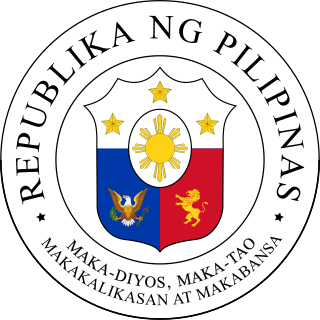
The coat of arms of the Philippines features the eight-rayed sun of the Philippines with each ray representing the eight provinces which were placed under martial law by Governor-General Ramón Blanco Sr. during the Philippine Revolution, and the three five-pointed stars representing the three major island groups of Luzon, the Visayas, and Mindanao.

The national flag of the Philippines is a horizontal bicolor flag with equal bands of royal blue and crimson red, with a white, equilateral chevron at the hoist. In the center of the triangle is a golden-yellow sun with eight primary rays, to represent the original eight provinces that rebelled against the Spanish during the 1896 Philippine Revolution. At each vertex of the triangle is a five-pointed, golden-yellow star, each of which representing one of the country's three main island groups—Luzon, Visayas, and Mindanao. The white triangle at the hoist represents liberty, equality, and fraternity. A unique feature of this flag is its usage to indicate a state of war if it is displayed with the red side on top, which is effectively achieved by flipping the flag upside-down.

Quezon City, also known as the City of Quezon and Q.C., is the most populous city in the Philippines. According to the 2020 census, it has a population of 2,960,048 people. It was founded on October 12, 1939, and was named after Manuel L. Quezon, the second president of the Philippines.

Epifanio de los Santos Avenue, commonly referred to by its acronym EDSA, is a limited-access circumferential highway around Manila, the capital city of the Philippines. It passes through 6 of Metro Manila's 17 local government units or cities, namely, from north to south, Caloocan, Quezon City, San Juan, Mandaluyong, Makati, and Pasay.

San Juan, officially the City of San Juan, is a highly urbanized city in the National Capital Region of the Philippines. According to the 2020 census, it has a population of 126,347 people. It is geographically located at Metro Manila's approximate center and is also the country's smallest city in terms of land area.

The seal of the president of the Philippines is a symbol used to represent the history and dignity of the president of the Philippines. Its original form was designed by Captain Galo B. Ocampo, secretary of the Philippine Heraldry Committee, and patterned after the seal of the president of the United States. It was first used by President Manuel Roxas in 1947.

The Amoranto Sports Complex is located in Quezon City, Philippines.

The Presidential Broadcast Service - Bureau of Broadcast Services (PBS-BBS), is a state radio network owned by the Philippine government under the Presidential Communications Office (PCO).
The 45th Infantry Regiment was a unit of the Philippine Scouts in the Philippine Division.
The Mendiola massacre was an incident that took place on Mendiola Street, San Miguel, Manila, Philippines on January 22, 1987, in which state security forces under President Corazon Aquino violently dispersed a farmers' march to Malacañang Palace in protest for the lack of government action on land reform.

The seal of the vice president of the Philippines is a symbol used to represent the history and dignity of the vice president of the Philippines. Its design was prescribed by Executive Order No. 310 of 2004, and is similar in design to the seal of the president of the Philippines.
The Ang Bagong Lipunan Series is the name used to refer to Philippine banknotes and coins issued by the Central Bank of the Philippines from 1973 to 1985. It was succeeded by the New Design series of banknotes. The lowest denomination of the series is 2-piso and the highest is 100-piso.

The Elliptical Road is a 1.98-kilometer (1.23 mi) roundabout in Quezon City which circumscribes the Quezon Memorial Circle, a large park. It was named after its elliptical shape. The spinning in this roundabout is in a counterclockwise direction. The road is divided into 8 lanes, wherein 3 are the main lanes, 4 lanes are for exiting vehicles with one lane for bicycles and pedicabs.

The Seal of Manila is composed of the city's modern coat-of-arms, with colors mirroring those of the Philippine National Flag. It is a modified form of the city's historical arms bestowed in the 16th century.

The following outline is provided as an overview of and topical guide to Metro Manila:

USS Carl M. Levin (DDG-120) is a United States Navy Arleigh Burke-class Flight IIA guided missile destroyer, the 70th overall for the class. The ship is named for Carl Levin, a former United States Senator and Chairman of the United States Senate Committee on Armed Services.

The Great Seal of the Philippines is used to authenticate official documents of the government of the Philippines.

Bagong Pag-asa, also known as the Magsaysay District, is an administrative division in eastern Metro Manila. It is an urban barangay of Quezon City with low-density housing and is known for its shopping malls, transport hubs and office buildings.





















